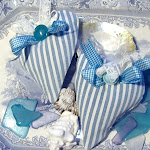Used to be, on Mother's Day in May,
faux eggs painted by me to resemble shorebirds' eggs i see in the nests
all the Canada geese would proudly troop out of the marshes with their bevies of newborn babies. Geese mate for life and seem to care for their babies, guarding them with great vigilance. And every year they’d look so proud. In recent years the pairs of adults are out---but, sadly, no babies at all. The adults appear bewildered and dejected (yes, humanizing, but still…). Too bad, even though of course we don’t want planes to crash. It is all very sad
Recent emergency landings and air crashes in and around NYC have been blamed on the abundant population of Canadian geese who live in the wetlands (their natural habitat) near the airports.
The plane that landed [safely] in the East River last year ago had engine failure due to “sucked-in aviary detritus”---the poor geese. There is a local campaign to eradicate these geese and the Fish and Game guys “oil” their eggs so they do not hatch. A statistic for a small portion of just Long Island was that 5000 eggs were “made unviable” last year. (What does oiling the eggs do, exactly? Do the embryos suffocate? or the infant birds cannot crack out of the eggs? what? It sounds very cruel.)
Meanwhile our beaches have been made inaccessible [fenced to the tide line, plus threatening signs] because those same environmental police are protecting another bird: the piping plover (as well as terns and oystercatchers). Once upon a time Canadian geese were a protected species too---will our children grow up to see the plovers’ babies “made unviable”---if their numbers increase and impinge on the human world?
So today, on the way to the flea market, you can imagine my joy after passing pair after pair of baby-less geese, I saw, near a beach area, a family with perhaps a dozen chicks! It made my Mother's Day.
On a happier note, I've been thrilled too to again watch my Oystercatchers return
courting displays
and mate and lay their eggs.
pair#1, note distinctive white patches above wings
I have 4 pairs I consider my own; Oystercatchers also mate for life (though sometimes in threesomes! Huh!) and return to nest in exactly the same spot each year.
... and exactly on one month later, on April 23rd I saw "my" original pair (Pair #1) choose a west-facing dune site:
...the female was actually laying her eggs as I carefully watched from a distance.
I was overjoyed to share her moment.
They are elongated, but about the size of a medium hen egg!
Sometimes I wonder if this tiny flock has come to know me. They seem fairly tolerant of my presence after five or six years and do not attack me or fly away when I slowly and ever so carefully approach at an oblique angle. Oystercatchers from the other nesting areas to my east can be much more aggressive...and the terns and skimmers are downright scary!
The following day I found the fourth pair (Pair #4) that nest furthest west.
pair#4, note bright blue balloon at far rt edge of photo!
That pair made their nest behind a driftwood log, next to a bright blue Mylar balloon, up on the south-facing dunes.
I carefully snuck up to all these nests to take pictures with a long-distance lens. (Oystercatchers do not continuously sit on their nests during the warm sunny day hours, apparently.)
The second pair (Pair #2) made its nest in its usual spot near the back of the beach next to my home.
She is a tiny black speck, seated below the deeper green area of the dunes , center top third of pix
I can see her sitting there, using a long lens or binoculars but that pair are protected by the plover fencing so I cannot approach.
The final pair (Pair #3) nested right in the center of the big open beach
Nest#3, female seated, top third of pix, center
You can see her saying, "What? I liked it here. I can see everything...including you!"
here are her eggs
I worry that a high tide could reach her nest though. And I cannot imagine what the high winds of the weekend's storm have done to these charming and rare birds' nests. I hope they are safe and not frightened.....
New chickies should hatch by 4th of July.
Oh and PS: the piping plover pair [PP#1] made their nest right on the tide line in the center of my beach! It is now about 60% enclosed/prohibited at high tide. Last year she nested right smack dab on the beach access path, pretending she was camouflaged by a large clam shell.
Sometimes I think it's no wonder these little cuties are nearly extinct.
love
lizzy
a worried daddy in the "waiting room"
gone to the beach......




























.jpg)















I spotted a nice oystercatcher model on the right side of the blog. May 10th 2010. Do you know where it is/was and or if its for sale. Thanks adrianboyle@westnet.com.au
ReplyDelete